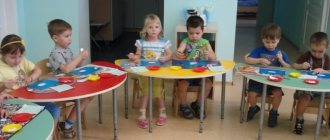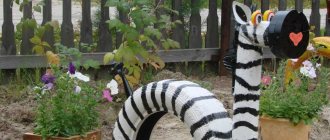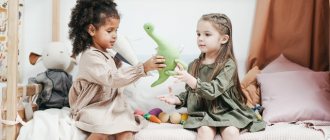Creative abilities of preschool children
Creative abilities, like intellectual ones, belong to the group of cognitive abilities. Only the main load falls on various cognitive processes. In intellectual cognition, thinking plays a leading role, and in creative cognition, imagination plays a leading role. Therefore, the creative abilities of preschoolers begin to develop later - in the second half of preschool childhood.
A child can try on pyramid rings to fit them to size as early as two years of age. This indicates his intellectual development. But a preschooler will be able to see a new image in the same pyramid, calling it “girl”, “slide”, etc., when he receives numerous ideas about the world, comprehends analogies and activates his imagination.
The creative abilities of preschool children are an original approach to understanding the environment, a tendency to find non-standard ways and means of solving problems, and a desire to obtain original results.
Children can realize their creative potential in any type of activity. By drawing or constructing a structure, performing actions with toys, or being carried away by role-playing games, preschoolers are guided by their plan. Since the plan is formed on the basis of how the child perceives the surrounding reality, it can reflect a typical picture, but it can also be very unusual.
Directions for the development of children's creative abilities
Creativity rarely develops on its own. Their development needs stimulation. For this reason, it is important to know in what directions the creative abilities of preschoolers can be developed. There are two effective lines:
- Complicating actions in using means to implement plans
- Expanding the set of tools to solve a specific problem
As an example, consider how children use a bucket. In addition to its direct purpose, it can serve as a form for Easter cakes, the upper part of a constructed tower, a headdress, a chair, a support for a bridge, etc. But children come to this variability with the development of creativity.
The same goes for finding new means to realize your ideas. You cannot draw an outline - a preschooler will lay it out with sticks; no sticks - will line up cubes around the perimeter; there are no cubes - he will stretch out a jump rope or a strap... If there are no more or less suitable means, the older preschooler will act in imaginary circumstances.
Every time the search for suitable means and possibilities for their use is a kind of brainstorming for the creative thinking of a preschooler. Experience confirms that the most original ideas come AFTER trying more familiar options. It is important for adults to remember this fact and encourage the child’s activity in generating new ideas.
WHAT IS IT FOR?
So what does this creative potential give to a child?
- The ability to see what is hidden from others.
- The ability to synthesize many original ideas in a short time.
- Associate concepts that are not related at first glance.
- Apply to solve one problem the skills acquired in solving a completely different one.
- Create certain conditions under which an object exhibits hidden properties or capabilities.
- Find an alternative solution to the problem at hand instead of looking for an answer by going through ready-made options.
All this opens up broad horizons for self-realization. The less creativity is developed in a person, the more prone he is to constant dissatisfaction with others and himself, to self-criticism. Such a person builds subconscious barriers to achieving a goal and is afraid of bold decisions and big-picture thinking.
We should not forget that the entire culture of any people and humanity as a whole would be impossible without creativity. Literature, sculpture, architecture, painting, folklore - all this is the result of the creative activity of many people.
Even in science you cannot do without creativity. After all, first you need to imagine a task or object, its properties, benefits, etc. And then imagine how this can be achieved. And you don’t always need to think within the framework of standards.
Features and signs of development of creative abilities of preschool children
The preschool period is especially favorable for the development of artistic and creative abilities.
The child gets acquainted with visual and constructive activities, pays attention to the musicality of the surrounding world, and tries his hand at creating drawings, crafts and buildings.
A clearly expressed cognitive need of a preschooler is a sign of creative potential. In addition, abilities for various types of artistic activity have specific characteristics. It is useful for parents to know how children's inclinations in certain creative areas manifest themselves.
Signs of creative abilities of preschoolers in art activities
The very way and what means a child chooses to realize his plan indicates the presence or absence of a creative approach. A few more telling signs about the presence of abilities in visual arts:
- A preschooler prefers drawing or modeling as soon as he has a choice of what to do.
- As part of the plot, it depicts a large number of objects and people.
- He chooses original subjects for his drawings. For example, he does not depict the usual house-tree-flowers, but paints a sky strewn with stars around a shining sun, and calls his picture Cosmos.
- Resorts to drawing or sculpting to express his mood and feelings.
- He uses new material with interest to implement his plans, and is also eager to try out a new medium in practice (sculpt from clay, not plasticine; draw with paints instead of pencils).
- Shows interest in works of painting and sculpture - examines, speaks out about the painting or statue he sees.
Creative talent in theatrical activities
Attentive adults notice artistic talent in a child from early preschool age, as soon as the child develops speech skills. Later, nonverbal expression comes into play, complementing the expressive signs of artistry.
- Likes to imitate colorful characters from fairy tales and cartoons, trying to convey the tone of speech and characteristic movements.
- He easily takes on any role, imagining himself either as a friendly dog, or as a dangerous wolf, or as a Wizard.
- Actively uses facial expressions, gestures and movements to convey the feelings and character of the image.
- Seeks to evoke an emotional response in others when telling something or portraying a character.
- Uses attributes (appropriate clothing, distinctive supporting details) to emphasize his suitability for the role.
- He enthusiastically watches children's performances, be it a theatrical game or a puppet show.
Signs of abilities for speech creativity in preschool age
What features should adults look for in order to notice the makings of literary talent in a preschooler:
- The child listens carefully to fairy tales and children's stories. At some plot points he stops the narrator and asks clarifying questions.
- Can compose a story himself, observing the key structure: a semblance of a plot plot, a climactic event and a final moment. For younger preschoolers, such stories can literally consist of 4-5 sentences, but the structure of the story can be traced.
- Comes up with something original when he retells a well-known story or fairy tale.
- When talking about something, he adheres to the storyline and main idea.
- Uses words that convey the experiences and feelings of the characters.
- He explains some points in particular detail so that listeners understand what is happening.
Creating conditions for the development of creativity
Every year, the ideas and actions of a preschooler improve and become more complex. Creative abilities develop in close connection with imagination. Even without external pushing, a child is interested in discovering new horizons of his achievements. And if he is additionally carefully directed to search for non-standard solutions, the results will become original.
Developing creativity through story writing
Without creativity, it is impossible to compose your own story. After all, the child needs to extract from memory suitable characteristics for invented characters, place them in imaginary circumstances and fantasize the actions of his heroes.
To create images you need material. The more of it there is in a child’s memory, the more variably the child will use it.
Parents stimulate the development of creative abilities in preschoolers if they not only read and tell them fairy tales and other children's works, but also encourage them to write:
- How would everything have happened if the main character had acted differently?
- What magical object would be useful to the hero of a fairy tale, and how would it help him?
- How differently could the story have ended?
Questions like these encourage children to first modify and add to existing works, and then create their own stories.
Construction as a means of developing creativity
Direct activation of creative abilities occurs in the process of constructive activity. If we keep in mind construction design, then children rarely build the same objects. They conceive new buildings, find new ways to implement their ideas.
In addition, during the process, the young builder can change his plans several times. As a result, its design acquires new details, improves, and changes its purpose.
It is imperative to ask the preschooler what he built, what the structure is intended for, how to use it, how it differs from the previous one, etc.
Paper design is an unlimited field for creativity. For a child, this type of creative activity becomes available in older preschool age with the development of manual skill. A complex type that is implemented at the suggestion of an adult and with his leading role.
At first, the child only observes what an ordinary sheet of paper can turn into in skillful hands, then he tries to repeat it with the direct participation of an adult. And only older children try to design the product themselves.
What materials are used for the work?
A variety of materials are used for children's creativity. These can be natural, waste materials, fabrics, ropes, old things, paper and much more. The purpose of decorative art is to use available materials to create something that could be used in everyday life or serve as decoration.
Materials you will need:
- paper: colored, corrugated, writing, papyrus, velvet, newspaper, double-sided, self-adhesive, tracing paper, paper napkins, foil;
- cardboard: white, colored;
- fabric: cotton, linen, synthetic, colored, plain, with patterns;
- cotton wool: cotton wool, cotton swabs and disks;
- natural material: seeds of plants, fruits and vegetables, cones, acorns, leaves, tree branches, feathers, stones, sand;
- different types of cereals, curly pasta;
- waste material: plastic cans, boxes, lids;
- wooden sticks, toothpicks;
- decorative elements: beads, rhinestones, seed beads, sequins, braid;
- plasticine, salt dough, clay;
- threads and ropes of different types and different colors;
- glue stick for paper, starch paste, PVA glue;
- paints, brushes, felt-tip pens, pencils, markers;
- wet wipes for hands, oilcloth, sippy cup for water.
The role of the family in the development of creative abilities of preschool children
Who, if not the parents, is obliged to notice what the child is more drawn to, what his capabilities are in a particular period, and on the development of what abilities it is important to focus the main attention.
Of course, a preschooler’s personality should be enriched in different directions - teaching drawing and modeling, designing and inventing stories together, organizing a simple home theater. In each of these types of activities there is room for the transformation of reality and the manifestation of creative abilities.
Most children do not have a special interest in all types of activities, but highlight priority ones for themselves. It is in this field that parents should create conditions so that the child discovers new means and expands the options for using them to realize his plans. Directed efforts of loving and understanding adults, unobtrusive participation in children's games and activities can and should be used to develop the creative abilities of preschoolers.




